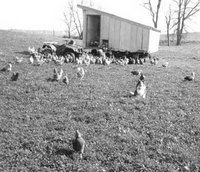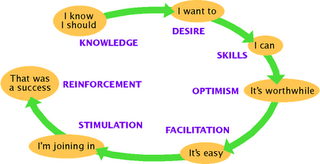Here is the second installment on my delving into the perhaps weakening factual basis for my eco/sociological vegetarianism. If you are an Ethical Vegetarian, or Gaia help me… a Vegan, you will find little to agree with here, and possibly even become spitting mad, because we are starting from different ethical worldviews. Personally, though I do not find killing animals for my food pleasant, I also feel that humans are omnivores and I have no moral objection to eating meat. So for the curious among all groups, please read on.
In our quest to reduce our ecological footprint, and eat healthier to boot, we have spent muchenergy attempting to eat as local as possible. This trend has gotten us out to talk to several more farmers and tour their farms. All of this keeps pointing me to one conclusion: that farms work best, maximising yield and minimising inputs, with an integrated relationship is fostered between plants and animals. Our grandparents knew this to be self evident, Permaculture espouses it, and nature wouldn't function any other way. The best way to cycle nutrients on a farm is to use our microbial friends (soil and compost) and animals to make nutrients available in a form that plants can use to create surplus calories from the sun which can then feed us humans and the animals. It’s a nice tidy system. Without animals on the farm, you invariably need to import fertilizer or organic matter to make the needed tons of compost, incurring transportation costs and burning more fuel. And even then, raw manure, especially urine, is still the best fertilizer. By splitting the system we are wasting energy to poorly mimic what nature will give us for free.
Permaculture gardening stacks vegetables in tightly to grow as many calories in as little acreage as possible to maximize yields and minimize inputs. One can grow corn, melons, and beans in the same area you could grow any one of the three and drastically increase your yield. Taking some of the learning’s I am getting from Permaculture,
Joel Salatin, and
Gene Logsdon I am beginning to think there is an even better way. Taking this out another step you can run geese

thru the field while it is in production to eat slugs and weeds, and then post harvest run cattle or goats through to eat the roughage we can't-increasing the yield of edible calories. But we aren’t done yet, while the cattle are in send in chickens and they will graze on weeds, eat insects, and keep the cows healthier by eating parasites out of their manure. Before you’re done send the swine thru to churn up the whole works for next year while they eat grubs and other pests. All four will add healthy quantities of manure (cows as much as 50lbs/day
each) to replenish the soil with zero petrochemicals spent in processing or transport. Animals make sense on a farm, or even in the garden, as they increase on site resource use, food production, and cut back on imported resources: keeping it local and closing the resource loop.
The cold truth is that farms don’t make a lot of money-they never have and they never will. That means, unless you are living off grants or subsidies, every single item on a farm needs to make money-and the more ways the better. This also means that you can’t afford to keep geese just to eat slugs-you also need to eat/sell the meat to make up for the added expense of their housing and care. Dairy cows (interchange goats as needed) once seemed like a great vegetarian alternative to me as you could make money off of them without the whole blood and gore piece. But this just proves that I am an ignorant city slicker-and a male one to boot. Why do cows give milk? Same reason all mammals do-to rear their young. That means that once a year you need to “freshen” the cow through having her “throw” a calf and then keep her in lactation for the rest of the year after you wean off the calf. If that calf is a heifer-great! You just expanded your herd. If it’s a steer or if you don’t need any more dairy cows, well it gets raised for meat. Some farmers, like Gene Logsdon, will raise those calves all year on pasture and sell them in the fall as grass fed Baby Beef-very different than a veal calf raised in a 16 sq ft pen all its very short life. This fact has pushed Mia even closer to giving up dairy completely. There really is no way around this-no one really keeps cows for pets-too darn expensive.
Egg laying chickens are better, they are much more feasible for the gardener as a small flock is inexpensive, relatively low maintenance, and apparently their egg production goes on regardless of breeding. I have read of numerous families treating these chickens as pets, and burying them

out behind the Oak tree by Mildy the Cat when their days are done. But for a money making enterprise you need a lot of chickens. Organic Valley won’t even pick up your eggs unless you have over
2000 birds (though this is manageable on as little as
4 prime acres), and that is a lot of chicken graves to dig. More likely you will sell them for low quality meat after they have lived out their egg laying lives because now you need to extra revenue to pay for all that extra fencing, feed, medication, and housing. The long and short of it is that unless you are raising animals for show, the only way to have most animals on a farm is to raise them, at least in a final gasp of revenue, for meat.
This is not to say that I think of all things on a cost benefit analysis, but with arable land prices in much of the country escalating past $3000/acre, and here in WI at more than $5000/acre if we want small family farms to succeed they simply must be profitable-and nothing on a farm will make as much money with as little effort (read family-not corporate- farm) as integrated, diversified livestock management alongside a vegetable and grain/pasture operation.

In all of the above I am utilizing Natural Capitalism, and accounting for the real costs of things like effluent flows from Concentrated Animal Feeding Operations (CAFO’S) at right, transportation from buying your cattle feed from Argentina because its “cheaper”, or in dumping petrochemical fertilizer onto your field to increase yields while destroying the soil. You can make money off land that way, even at $3-5000/acre, but you are forcing future generations to foot the environmental bill-which should be criminal. Plus that is not the kind of farming I want to save anyhow. From one point of view farmers are artisans, combine operators are drivers, and CAFO operators just might be Evil.
If I became a vegetarian to reduce my ecological footprint it is becoming more clear that what I am protesting was not meat-but the eff’d up way that we are raising meat-growing the food thousands of miles from the cattle, and then forcing the cattle into CAFO’s to create massive effluent issues and intolerable living conditions. The degradation of energy argument losses some momentum if the energy being degraded was never in a form humans can consume-like fouled melons or corn stalks.
As I said in the beginning, raising meat humanely and offering the animal a clean death is not morally wrong to me. What we do to animals in CAFO's makes me fighting mad and want to join PETA. This bears thought.
Labels: Gardening, sustainable agriculture, Sustainable Development
 Stumble It!
Stumble It!
 Stumble It!
Stumble It!












